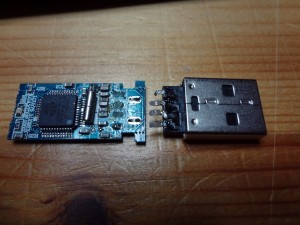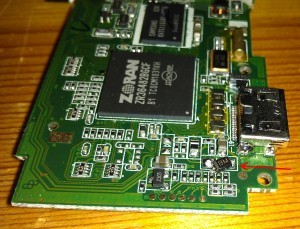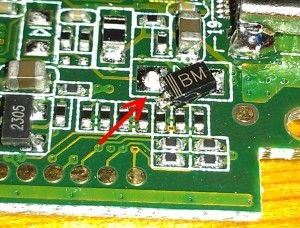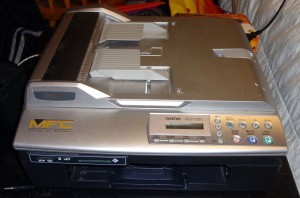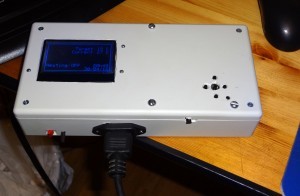USB Stick Data Recovery
It isn’t the first time, and it probably won’t be the last. Today I had a client e-mail me in some panic, as her USB memory drive had stopped working. It was plugged into the computer, and someone walked into it, bending the connector.
Breaking the 64MB, chinese-made promotional USB key was not the disaster – it was losing the files on it.
I’ve had luck before re-soldering damaged USB key connectors, so I got my tools together and gave it a shot.
Custom Car Bluetooth Receiver
Currently my phone is simply connected to my radio’s AUX input with a cable, and if I want to change songs I must do so from the phone. Modern raidos have integrated Bluetooth capabilities, allowing you to pair your radio to your phone wirelessly. In some cases, pausing and skipping tracks can be done directly from the radio’s buttons – safer than waking up and unlocking your phone to change songs within the music player app.
I could have purchased such a radio, but I already had a perfectly fine JVC unit I installed not even two years ago. It has two AUX inputs, the one in the front I’ve been using, and a special Bluetooth AUX input in the rear. Although designed for use with a JVC accessory, I decided to build my own Bluetooth receiver for my car.
Daniel Joannis – Rhythmind
It has been 5 years and 2 days since the idea of Rhythmind was born. On November 16th, 2007, I recorded my first full-length song, “Dance Hall Dream”. It was exciting, seeing that I could write music, and knowing that I had the potential to make music I really liked.
I didn’t stop, and my Compositions folder is a testament to that, with over 100 project files, most incomplete. However, Rhythmind bundles up some of the finished songs, and presents them in an album format we are all familiar with.
All 13 songs are available, in their entirety, to be listened to at http://music.danjoannis.com. If you like them, $5 $0 or more will get you high-quality downloads in almost any format you wish. If you prefer a physical copy, send me a message.
Music has the power to alter perspective and change the way we feel, and to me, Rhythmind does both quite well. Listen for yourself.
Quick Flip Fix
After a weekend at the Ottawa Pinball and Gameroom Show ’12, I came home to find that one of my Flip HD video cameras had stopped powering on. It functioned without problem when connected to the computer to copy the videos from it, but it would not turn on to record.
Today, I finally decided to open it up and figure out the cause. I suspected perhaps the power switch was bad, since it didn’t seem to be a major system failure. When I opened it up, the problem was as clear as day:
As you can see, something isn’t sitting quite right. One of the diodes became un-soldered, perhaps due to a shock, causing an already cracked solder joint to completely give up.
Simple enough to fix, a quick test with a multimeter, two points of solder, and everything was back to normal.
You never know if a task will be easy or difficult without first taking a look.
Ottawa Pinball and Gameroom Show ’12
This year marked the second annual Ottawa Pinball and Gameroom Show (I tend to call it the Pinball Expo). On Friday, September 7th, 2012, over 50 pinball machines were installed at the Hilton Garden Inn by the Ottawa Airport, and by Saturday, there were around 60+ tables. The show spanned from September 8th to the 9th.
As per last year, I made a video of the show, but I was much more ambitious this year. I ended up creating something more documentary styled, incorporating multiple interviews, to find out the more personal side of pinball. The video is indeed a bit un-conventional, but I am pleased with it.
Modifying a Flip Video UltraHD to Add Charging Capabilities
The Cisco Flip Video UltraHD is a very basic 720p video recording device. It has a screen, a few buttons, and USB and HDMI ports. Not very much going on. Record, play back, copy to computer. However, these devices were discontinued, so my friend and I bought two to share at $29 a piece. I was very keen on using them together for 3D video.
To prepare for this weekend’s 2nd annual Ottawa Pinball Expo, I was making sure all my camera gear’s batteries were charged. The Flip UltraHD takes 2 AA batteries, which is generally enough to allow you to completely fill the camera’s 1 hour internal memory.
I noticed that there was a rechargeable battery pack you could buy for the Flips. It charges when the camera is plugged in to a USB port. This battery pack is really just two AA NiMH rechargeable batteries wrapped together, with a little tab that pushes on a switch to tell the camera that the pack is installed, and not regular AAs. When I realized this, I figured I could modify the Flips to work with my own AA NiMHs, and charge when connected to my computer.
Restoring a Bally Medusa
I’ve talked about electronic maintenance on our pinball machines before, including some fairly serious refurbishing. One type of restoration my father and I were hesitant to try was cosmetic, since we aren’t exactly artistic.
Well, we did it anyway! Read on for a full, detailed account of our journey restoring a Bally Medusa.
Refurbishing a Brother DCP-120C Inkjet Printer
About a month ago my neighbour gave me an old Brother DCP-120C printer/scanner. The auto-document feeder was what caught my eye at first, but after I looked more closely, the type of ink cartridges it used made me very happy with this gift: they are simply little tanks of ink, with no head, meaning they are very easy to refill and should last a long time. What’s more, it only cost $7 for a full set at 123inkcartridges.ca.
However, after ordering the new cartridges and trying to print, I encountered some problems: nothing came out, except for trace amounts of colour – no black, and it certainly was not printing properly.
This is the inherent design flaw of these printers: they have a fixed print head, that is part of the printer. Unlike HPs and Canons (to name a few), the print head isn’t part of the cartridge. This means that if the printer is left sitting for long, and the ink clogs the head, the whole thing needs to be disassembled and either cleaned, or the head replaced.
Print head on an HP cartridge – replaced whenever you
buy a new cartridge.
Being the do-it-yourselfer I am, I decided I would tackle the task of refurbishing this printer.
Final Project – Final Writeup
After yesterday’s exam, I have completed the Electronic Technologies program at Heritage College! Although final marks are not yet posted, graduation is certain, and I can pretty much call myself a Technologist (except not officially).
The biggest part of this third and final year was the final project. I’ve made a few posts in the past about it (video, menu, schematics), and the original plan was to make separate blog posts for each step of the process. However, time constraints, and the sheer volume of material, makes it easier if I just provide this summative post.
This post will be divided down into two main sections: hardware and software. I will try to explain with detail while keeping it short, and cover some of the key elements and choices involved in making this project.
Daniel Joannis – Midnight Oil
A new song release, long overdue. Another production that really represents my musical style, this song makes much use of the lower frequencies. It is best heard with a good pair of headphones or speakers.
